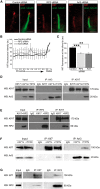Arl3 and RP2 regulate the trafficking of ciliary tip kinesins
- PMID: 28444310
- PMCID: PMC5808637
- DOI: 10.1093/hmg/ddx143
Arl3 and RP2 regulate the trafficking of ciliary tip kinesins
Erratum in
-
Arl3 and RP2 regulate the trafficking of ciliary tip kinesins.Hum Mol Genet. 2017 Sep 1;26(17):3451. doi: 10.1093/hmg/ddx245. Hum Mol Genet. 2017. PMID: 28854704 Free PMC article. No abstract available.
Abstract
Ciliary trafficking defects are the underlying cause of many ciliopathies, including Retinitis Pigmentosa (RP). Anterograde intraflagellar transport (IFT) is mediated by kinesin motor proteins; however, the function of the homodimeric Kif17 motor in cilia is poorly understood, whereas Kif7 is known to play an important role in stabilizing cilia tips. Here we identified the ciliary tip kinesins Kif7 and Kif17 as novel interaction partners of the small GTPase Arl3 and its regulatory GTPase activating protein (GAP) Retinitis Pigmentosa 2 (RP2). We show that Arl3 and RP2 mediate the localization of GFP-Kif17 to the cilia tip and competitive binding of RP2 and Arl3 with Kif17 complexes. RP2 and Arl3 also interact with another ciliary tip kinesin, Kif7, which is a conserved regulator of Hedgehog (Hh) signaling. siRNA-mediated loss of RP2 or Arl3 reduced the level of Kif7 at the cilia tip. This was further validated by reduced levels of Kif7 at cilia tips detected in fibroblasts and induced pluripotent stem cell (iPSC) 3D optic cups derived from a patient carrying an RP2 nonsense mutation c.519C > T (p.R120X), which lack detectable RP2 protein. Translational read-through inducing drugs (TRIDs), such as PTC124, were able to restore Kif7 levels at the ciliary tip of RP2 null cells. Collectively, our findings suggest that RP2 and Arl3 regulate the trafficking of specific kinesins to cilia tips and provide additional evidence that TRIDs could be clinically beneficial for patients with this retinal degeneration.
© The Author 2017. Published by Oxford University Press.
Figures





Similar articles
-
Translational read-through of the RP2 Arg120stop mutation in patient iPSC-derived retinal pigment epithelium cells.Hum Mol Genet. 2015 Feb 15;24(4):972-86. doi: 10.1093/hmg/ddu509. Epub 2014 Oct 6. Hum Mol Genet. 2015. PMID: 25292197 Free PMC article.
-
The X-linked retinitis pigmentosa protein RP2 facilitates G protein traffic.Hum Mol Genet. 2012 Feb 15;21(4):863-73. doi: 10.1093/hmg/ddr520. Epub 2011 Nov 9. Hum Mol Genet. 2012. PMID: 22072390
-
The retinitis pigmentosa protein RP2 links pericentriolar vesicle transport between the Golgi and the primary cilium.Hum Mol Genet. 2010 Apr 1;19(7):1358-67. doi: 10.1093/hmg/ddq012. Epub 2010 Jan 27. Hum Mol Genet. 2010. PMID: 20106869
-
Arl3 and RP2 mediated assembly and traffic of membrane associated cilia proteins.Vision Res. 2012 Dec 15;75:2-4. doi: 10.1016/j.visres.2012.07.016. Epub 2012 Aug 2. Vision Res. 2012. PMID: 22884633 Review.
-
The role of the X-linked retinitis pigmentosa protein RP2 in vesicle traffic and cilia function.Adv Exp Med Biol. 2012;723:527-32. doi: 10.1007/978-1-4614-0631-0_66. Adv Exp Med Biol. 2012. PMID: 22183373 Review. No abstract available.
Cited by
-
Homozygous Variant in ARL3 Causes Autosomal Recessive Cone Rod Dystrophy.Invest Ophthalmol Vis Sci. 2019 Nov 1;60(14):4811-4819. doi: 10.1167/iovs.19-27263. Invest Ophthalmol Vis Sci. 2019. PMID: 31743939 Free PMC article.
-
In vitro metabolism, reaction phenotyping, enzyme kinetics, CYP inhibition and induction potential of ataluren.Pharmacol Res Perspect. 2020 Apr;8(2):e00576. doi: 10.1002/prp2.576. Pharmacol Res Perspect. 2020. PMID: 32196986 Free PMC article.
-
The hedgehog pathway and ocular developmental anomalies.Hum Genet. 2019 Sep;138(8-9):917-936. doi: 10.1007/s00439-018-1918-8. Epub 2018 Aug 2. Hum Genet. 2019. PMID: 30073412 Free PMC article. Review.
-
Modeling Retinitis Pigmentosa: Retinal Organoids Generated From the iPSCs of a Patient With the USH2A Mutation Show Early Developmental Abnormalities.Front Cell Neurosci. 2019 Aug 7;13:361. doi: 10.3389/fncel.2019.00361. eCollection 2019. Front Cell Neurosci. 2019. PMID: 31481876 Free PMC article.
-
Cytoskeletal regulation of a transcription factor by DNA mimicry via coiled-coil interactions.Nat Cell Biol. 2022 Jul;24(7):1088-1098. doi: 10.1038/s41556-022-00935-7. Epub 2022 Jun 20. Nat Cell Biol. 2022. PMID: 35725768 Free PMC article.
References
-
- Christensen S.T., Pedersen L.B., Schneider L., Satir P. (2007) Sensory cilia and integration of signal transduction in human health and disease. Traffic, 8, 97–109. - PubMed
-
- Fliegauf M., Benzing T., Omran H. (2007) When cilia go bad: cilia defects and ciliopathies. Nat. Rev. Mol. Cell. Biol., 8, 880–893. - PubMed
-
- Hildebrandt F., Otto E. (2005) Cilia and centrosomes: a unifying pathogenic concept for cystic kidney disease? Nat. Rev. Gen., 6, 928–940. - PubMed
MeSH terms
Substances
Supplementary concepts
Grants and funding
LinkOut - more resources
Full Text Sources
Other Literature Sources
Miscellaneous

